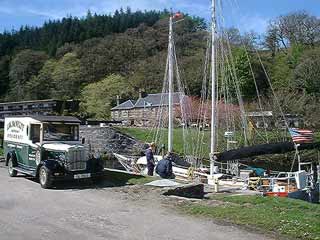
Ireland To Scotland, Spring, 2002, page 2

One of the repair jobs to be done was to repack the stuffing box. This requires being out of the water. There was no convenient wall to lie against in Lamlash, so Orbit was beached to do the work. Beaching just involves dropping a stern anchor (to pull off with later), and then running aground (on soft ground) shortly after high water. After the boat is aground, weight is put on one side to ensure that it lays on one side (if standing upright on its keel, it could crash over later if weight shifted), and when the tide goes out, the boat is safely ashore. When the tide comes back in, hauling on the stern anchor pulls the (now floating) boat towards deeper water.

Afterwards, we anchored (again on the second try, the first time, using the Fortress FX37 that we had just pulled off the beach with, it dragged, and came aboard with some kelp. Reanchored with the 20kg Bruce.
The next day, in a F6, the Bruce dragged. We were halfway out of the harbor when we noticed it and got the engine going. With a lot of work, we got the Bruce anchor back aboard. It was extremely difficult to haul up until about the last 20m of rode, when it suddenly seemed to be free of whatever it was attached to, and came up normally (and cleanly, with no sign of kelp).
We were now in a narrow part of the harbor, with a fish farm just to leeward, and it was a difficult place to try sailing to windward from, especially as we had not gotten the jib halyard fixed yet. The throttle cable had slipped, and without full throttle, we were unable to keep Orbit pointing into the wind. Used duct tape to hold the throttle wide-open, so that all 10HP could be used (this was one of those times that I wished I had a bigger engine). Full throttle gave us just enough power to very slowly make our way back in the lulls, and mostly hold position in the gusts. Finally, after three hours, we made it back.
A week later, after the weather improved, we had a pleasant sail up to Ardishaig, then entered the sea lock at the Crinan Canal. The Crinan Canal is 9 miles long, with 15 locks, and allows one to bypass the Mull of Kintyre (which is a narrow point in a shipping lane, and a place that is often rough). Most of the locks (all manual) are operated by the crew of the boats using them.
 |
 |
After the Canal, we made our way up the scenic West coast of Scotland, almost always in pleasant weather (favorable E winds, some sunshine and little rain).



Did our final provisioning and maintenance in Ullapool, in NW Scotland, then had a pleasant daysail over to Stornoway on the island of Lewis in the Hebrides. We anchored for the night for a short sleep, then, having a good long-range forecast, set off for Iceland the next morning (May 28, 2002).

Copyright Richard Hudson, 2002